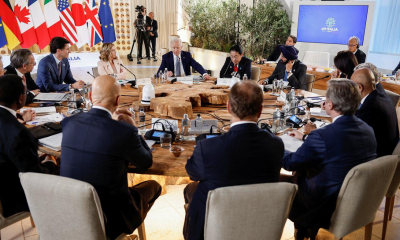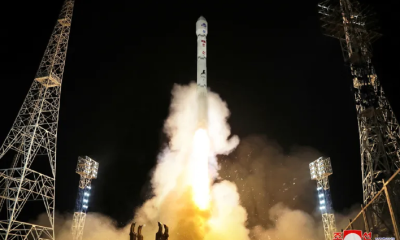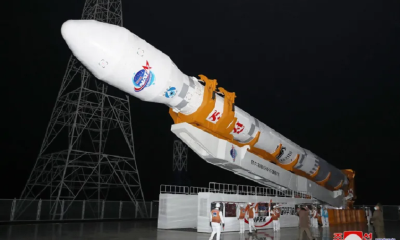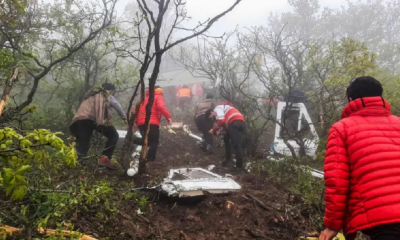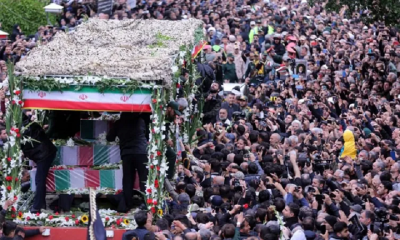Sports
Iran beat Japan 2-1 for a place in AFC Asian Cup 2023 semifinal
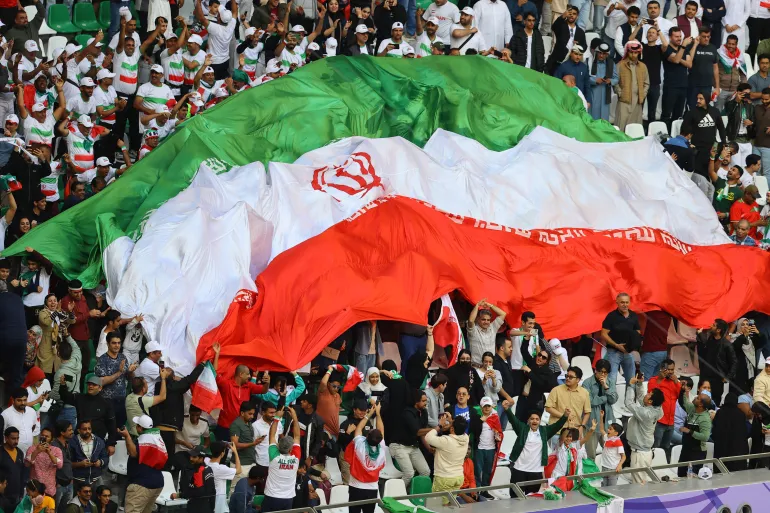
Iran, backed by their thousands of vociferous supporters, have knocked out favourites Japan and earned a spot in the semifinals of the AFC Asian Cup 2023 with a famous 2-1 win,
In a match billed as an early final of the tournament – given both teams’ history in the competition, their FIFA rankings and strong squads – Iran turned the tables on the four-time champions on a cool Saturday afternoon at Education City Stadium in Qatar.
In a tournament that is now well-known for its late drama, Iran’s captain Alireza Jahanbakhsh delivered one of the most famous goals in his country’s Asian Cup history with a heart-in-mouths stoppage-time penalty that booked Team Melli a place in the second semifinal on Wednesday.
The opening minutes of the game saw Japan make several bursts towards Iran’s goal but failed to convert their chances, much to the delight of the large Iranian contingent positioned behind it.
Hidemasa Morita changed that with his goal in the 28th minute and the small groups of Japanese fans scattered around the stadium finally made their presence felt. However, it did little to deter Team Melli’s supporters, who took up their synchronised clapping and chanting by a few more notches.
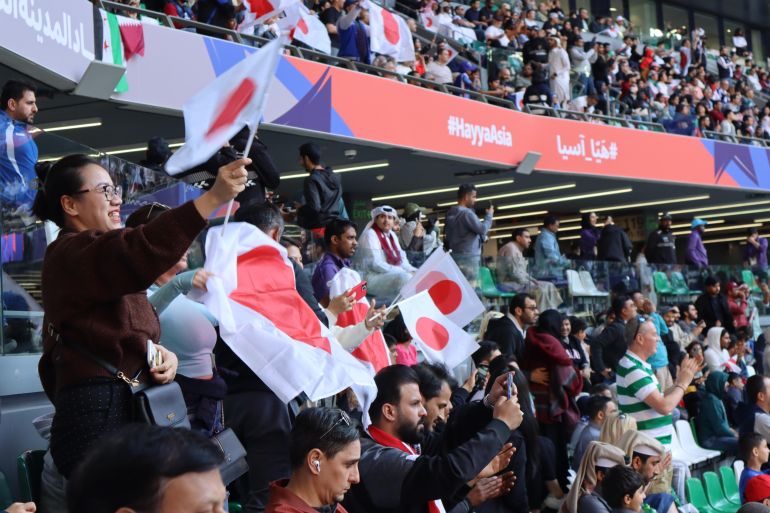
The team, one of the oldest squads at the tournament, pulled up their socks after half-time and began a back-and-forth contest with the Samurai Blue as they sought an equaliser.
Perhaps they were out to impress their coach, Amir Ghalenoei, who had slammed the team for missing several chances to score against Syria in their round-of-16 match on Thursday. “I’m not really happy with the performance of a few players but I’m very happy with the discipline we showed,” Ghalenoei had said.
Iran’s first goal finally came 10 minutes into the second half as Mohammed Mohebi slotted Sardar Azmoun’s through pass into the Japanese goal and sent their fans into a frenzy. Their unwavering support had finally paid off.

More than two-thirds of the spectators were either dressed in Iran’s colours or carrying Iranian flags. Some, like Wafai Salar, had travelled from across the Arabian Gulf to back their team. He came to Doha 10 days ago from the western Lorestan province to back his team in the latter stages of the tournament. “We must not doubt our team,” Salar told Al Jazeera before the match.
The belief was reiterated by 72-year-old super fan Mohamed Mirza, who said the team did not feel the absence of their star striker Mehdi Taremi, who missed out on account of his two yellow cards in the game against Syria. We have 24 Taremis in the squad,” he shouted after the match. “I have been living in Qatar for decades and have seen three Asian Cups here, so now the team owe me a trophy,” Mirza said before resuming his chants for Iran.
Indeed, Ghalenoei’s team showed they were up for the challenge against heavy favourites Japan by defending their goal and following it up with runs into the Japanese half. One of these, late into stoppage time, resulted in Iran winning a penalty.
The late drama was too much for some fans, who turned their backs to the pitch before the penalty was taken by Jahanbakhsh. Once the ball was deposited in the top left corner, pandemonium broke out in the stands and on the pitch. Iran’s substitutes ran onto the pitch to celebrate and their fans jumped out of their seats.
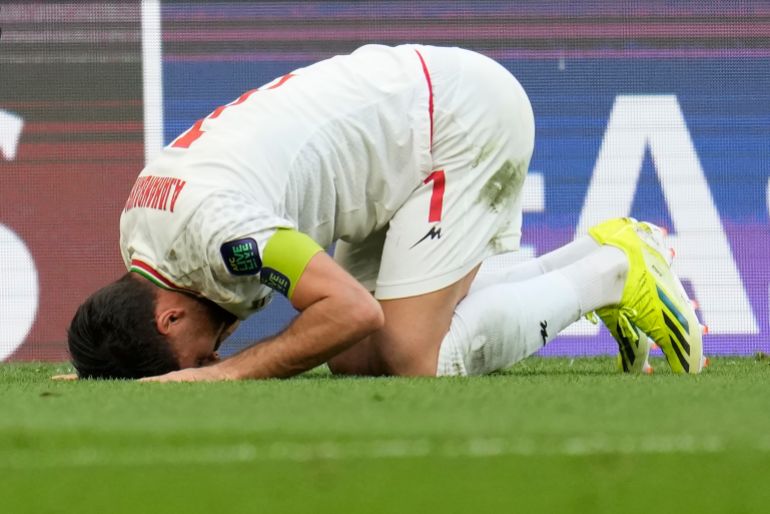
Three minutes later, the referee’s full-time whistle confirmed Japan’s dismissal. The Japanese fans seated behind their goal held their heads in their hands and shed tears of agony and disbelief.
Across the aisle, nine-year-old Iran fan Ario was crying, as well. The dramatic last-minute penalty was too much to take for the young supporter. “I was so nervous before the penalty was taken, I peeled the skin off my fingers,” he told Al Jazeera as tears fell down his cheek.
Ario, a Canadian Iranian citizen, has never been to the country of his parents’ birth but would one day like to play for Team Melli. “I get so excited every time I see them play, so I want to be like them one day,” he said.
![Iran football team fan Ario at Education City Stadium [Hafsa Adil/Al Jazeera]](https://www.aljazeera.com/wp-content/uploads/2024/02/20240203_163244-1706981525.jpg?w=770&resize=770%2C578&quality=80)
Ghalenoei’s men will give Ario and the millions of Iran fans the world over another chance to ride the wave of emotions when they take on the winner of the Qatar vs Uzbekistan quarterfinal in four days’ time.
For old-timers like Mirza, it may even be a case of third-time lucky if the three-time champions walk away with the trophy on February 10.
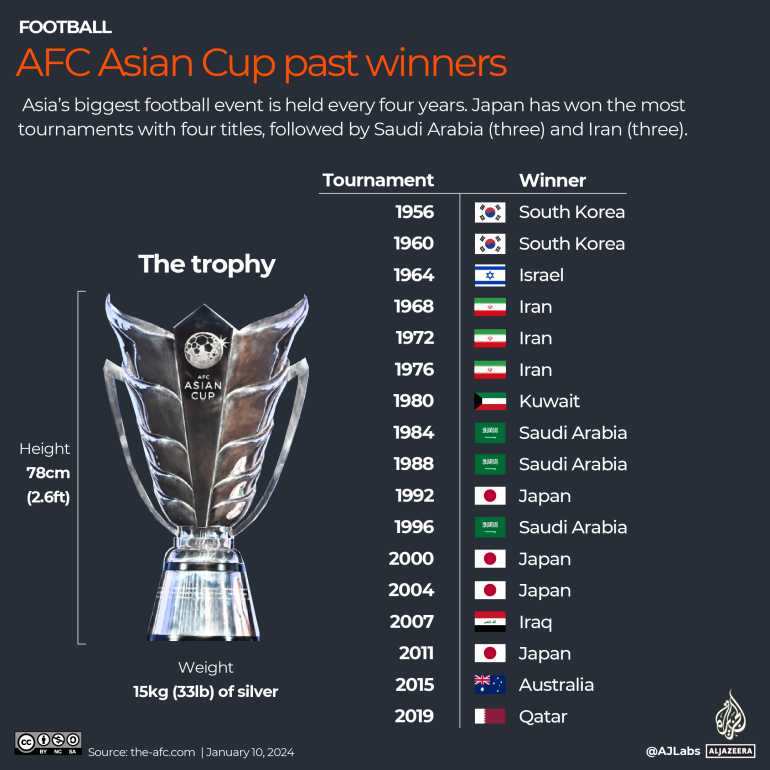
(Aljazeera)
Sports
Lankan legends, Modi and the Jaffna dream
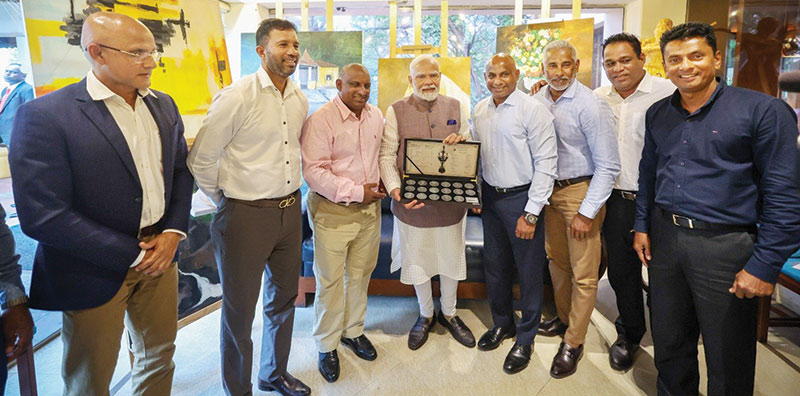
Tamil Members of Parliament with roots across the Palk Strait are often quick to look towards India at the drop of a hat. But last week, all they managed was a photo op with Indian Prime Minister Narendra Modi – smiles, handshakes and little else. In contrast, Sri Lanka’s 1996 World Cup-winning cricket team was granted a 45-minute chinwag over tea with the Indian leader. The Indian High Commission in Colombo had arranged the meeting. Not even former President Ranil Wickremesinghe, with all his so-called diplomatic finesse, has managed to get a similar audience.
Pictures of Modi rubbing shoulders with Sanath Jayasuriya and Aravinda de Silva went viral in India on social media and it was the talking point across news channels and print media as well. And why not? Not since the marauding days of Sir Vivian Richards have Indian bowlers been sent on a leather hunt quite like they were by these two Sri Lankan giants. It was déjà vu for Indian fans – memories of the Wills World Cup semi-final at Eden Gardens, still fresh like an old wound that refuses to heal.
During the meeting, Jayasuriya pitched an idea to the Indian PM – seeking help to build a cricket stadium in Jaffna. It wasn’t a doosra out of nowhere. There’s a deep and genuine passion for cricket in the north. Some of the school big matches in the region have stood the test of time, with legacies stretching back over a century. Yet, due to decades of conflict, the region has remained a barren patch in terms of producing top-tier cricketing talent.
Since the guns fell silent, though, there’s been a fresh crop of hopefuls from the north. Leading the charge is leg-spinner Vijayakanth Viyaskanth – a name that’s now turning heads. Though his First-Class stats are more than decent, Viyaskanth has chosen the glitz and glamour of franchise cricket, where the pay cheques are fatter and the schedule less grueling.
Behind the scenes, Sri Lanka Cricket’s (SLC) District and Provincial coaches have done a stellar job, scouting and grooming pace bowlers and other youngsters from these long-neglected areas. Some of these boys have gone on to wear the Under-19 jersey with pride – a sign that the talent pool is slowly, but surely, filling up.
However, SLC’s grand vision of building new stadiums to attract larger crowds has hit a few bumps. The old guard – some former greats – have been quick to swing the bat in criticism. They’ve taken their eye off the ball, failing to see the bigger picture. Take next year’s T20 World Cup, for instance. Co-hosted by Sri Lanka and India, it promises to be a blockbuster. The high-voltage India – Pakistan clash is set to take place in Colombo, with the R. Premadasa Stadium’s 35,000 seats expected to vanish like isso vade at the Galle Face green. A bigger venue – like the proposed facility in Homagama – would have been just the ticket to meet such mammoth demand.
But Sanath’s plea is in a different league altogether. He’s not asking for a behemoth like Eden Gardens or the Narendra Modi Stadium in Ahmedabad. His is a humble request – a ground with decent infrastructure and floodlights that can host day-night matches. A facility like that would be a game-changer for the north, a true shot in the arm. Nothing ignites a young cricketer’s imagination more than watching their heroes up close, not through a television screen but under the stars, in their own backyard.
At present, the closest international venue to Jaffna is in Dambulla—hardly accessible, especially for aspiring fans and players from the peninsula. A ground in Jaffna would not only bridge that distance but also build a bridge of hope and opportunity.
Back in 2002, when Janashakthi opened a branch in Jaffna, the great Muttiah Muralitharan made the long road trip to play a friendly match on a matting wicket. The welcome he received was nothing short of electric. The crowd adored him, showering him with affection that could rival the warmth of any southern stand.
Since then, we’ve hardly scratched the surface when it comes to understanding the region’s cricketing appetite. If the Indian government lends an ear to Sanath’s appeal, we might just discover a goldmine of talent waiting to be unearthed in the north. Who knows? The next Murali or Malinga might be bowling on a dusty street in Jaffna this very moment – waiting for a stage, a spotlight, and a bit of help from across the Palk Strait.
by Rex Clementine
Sports
Sri Sumangala’s cricketing miracle
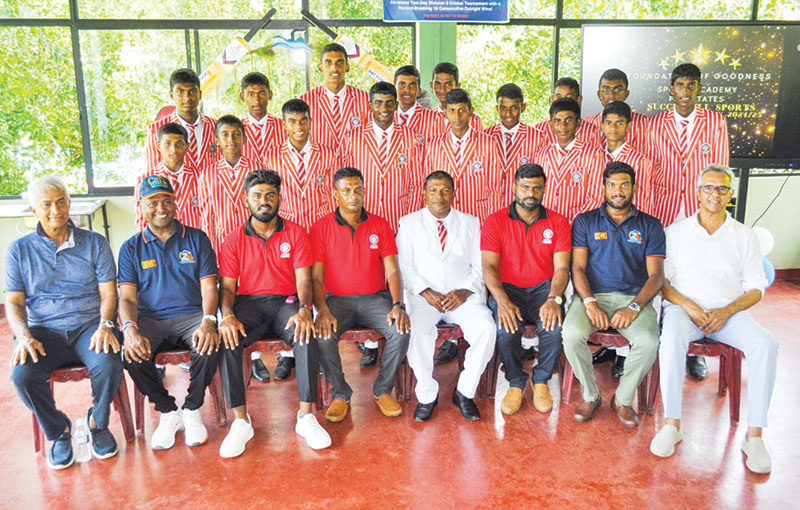
Sri Sumangala Vidyalaya, Hikkaduwa has scripted a fairytale rise in school cricket, marking a monumental milestone just 18 years after forming its first team. Once deprived of even a proper ground, the school now proudly boasts an unbeaten Under-19 team that has clinched both the Division III two-day and one-day championships — a rare double that has earned them promotion to Division 2.
The turnaround began in 2007 when the Marylebone Cricket Club (MCC) helped establish the Sri Sumangala MCC Lord’s Cricket Grounds following the devastating tsunami. This facility, offered free of charge, became a beacon for young cricketers who had talent but lacked opportunity. What followed is nothing short of a sporting miracle: 16 consecutive outright wins by the U19 team and national recognition in school cricket circuits.
This isn’t just a story of trophies and titles — it’s about breaking generational barriers. These young cricketers, once trapped in a cycle of poverty and obscurity, now inspire their community and set benchmarks for others in rural Sri Lanka.
The MCC’s early investment has borne fruit, turning dreams into tangible success. Today, the legacy of Lord’s lives not only in London but also in the hearts of the aspiring cricketers of Hikkaduwa — proof that when given a chance, talent can indeed take flight.
Foundation of Goodness has been a beacon of hope for sporting talents in the region and representation for Sri Lanka Women’s Under-19 team has been dominated by them. The same could happen with the men’s team in the near future.
Sports
St. Sebastian’s back on the basketball track
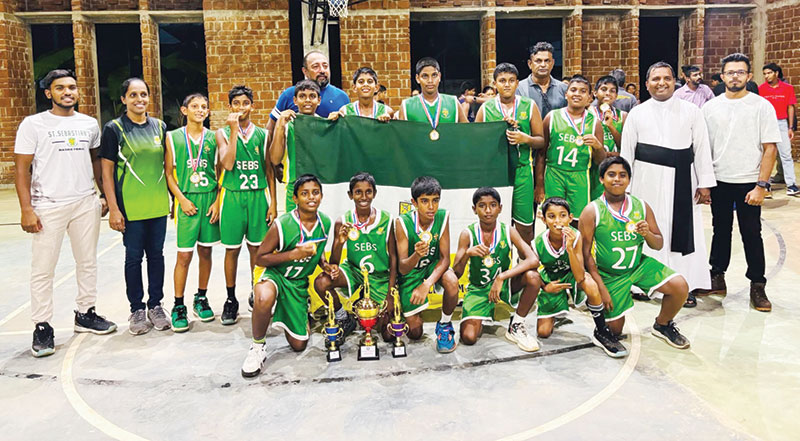
In the bygone years it was the Colombo schools that dominated basketball in Sri Lanka. Bens under Ram Sunderalingam, Peterites coached by Naufer Mahroof and the Josephians shaped by Mahadevan were the trojans who won tournaments. Led by this trio and flanked by other basketball playing schools in the capital, the game had its foundation laid down in concrete – Colombo style.
Moratuwa and Batticaloa were the painful thorns amidst the Colombo teams when it came to championships. And Trinco was the dark horse, almost unbeatable in their heyday, playing under the wizard, late Father Eugene Herbert. This is what basketball was, beginning from the sixties.
Today the faded memories remain. On a lucky day one might meet Doc Thurai, as he was popularly known, walking his wards with the stethoscope round his neck. He was the best we saw in that era. If one visits Batticaloa there is a prominent statue outside the town. It is of a tall Jesuit Priest. Here, he cradles a Wilson basketball ready to take a ‘time-out’ and yell at the referee. That is Father Herbert, the man who filled the Eastern Province with stellar players who left their luminous mark in the basketball courts of Sri Lanka.
More recently in April, on the 6th Sunday, I watched the under 13 ‘B’ division basketball finals between St. Sebastian’s and St. Thomas’ Prep. It was played at a flood-lit indoor court in Moratuwa. No, it certainly wasn’t in the league of Madison Square Garden, but it was more than adequate for a schools’ final. I sat on a wooden bench and watched the match thanking the court creator Sugath Thevarapperuma. I must mention this former national player who is doing yeomen service to promote basketball by establishing indoor courts in different locations.
Back to the match. It was good and exciting and the Sebastians won 37-36 by a solitary point. This was great for Moratuwa and the school and the young players. This victory would awaken the school and the basketballers from the doldrums they had been mired for a considerable time to say ;we are coming back’.
This 1-point victory I witnessed appeared to me as a catalyst for greater performances and perhaps an eye-opener for the Moratuwa lads. They are indeed capable of leaping bigger steps to reach higher pedestals in schools’ basketball championships. Yes, that is an achievable possibility, and the need is to change gears and go for the over-drive.
It is time for St Sebastian’s to forget the apathetic era and the reasons for such, and forge ahead with renewed motivation to re-claim former glories with their current potential.
The Thomians fought to the end. They certainly were equal in spirit and determination to become the champions. The difference was simply 1 solitary point. The pattern of play was the same by both teams and the award for the best player went to Akash Wijesinghe and Amantha Hettiarachchi was adjudged the best guard.
I noticed that some new rules have been introduced to control the game. The teams are only allowed to play ‘man-to-man’ and they could do so only from the center line. Additionally, the coach cannot use a double guard on the opposing best player. The teams are not allowed to use a zonal defense or play a floating man to man. If these rules came from FIBA then there is no argument. But if it is a local ramification of rules of how the game should be played, I have to humbly say that this will be a significant deterrent to coaches and players and a recurring headache to the referees. Over to you Sir, the Head of the Schools’ Basketball Association.
For me personally, it was an ‘Alma Mater delight’ to notice that the two coaches of the playing teams were both from St Sebastians and the assistant coach too was from my old school. Chaminda de Alwis and Susil Dias coached St. Sebastian’s and Isuru Perera the Thomians.
Chaminda captained the national team and Isuru had Ceylon Basketball colours and Susil represented All Island Schools.
Yes, St. Sebastian’s had a lot of glory days in basketball. Many of their players represented and captained the national team. Then one might ask, “how come they hit rock bottom playing a game they more or less dominated?”
The answer is simple, I will leave it for another day to elaborate.
On second thoughts, some things are best left unsaid.
by Capt. Elmo Jayawardena
elmojay1@gmail.com
-

 Business7 days ago
Business7 days agoColombo Coffee wins coveted management awards
-

 News2 days ago
News2 days agoSuspect injured in police shooting hospitalised
-

 Features3 days ago
Features3 days agoRobbers and Wreckers
-

 Features5 days ago
Features5 days agoSri Lanka’s Foreign Policy amid Geopolitical Transformations: 1990-2024 – Part III
-

 Midweek Review5 days ago
Midweek Review5 days agoInequality is killing the Middle Class
-

 Features7 days ago
Features7 days agoSri Lanka’s Foreign Policy amid Geopolitical Transformations: 1990-2024 – Part I
-

 Business2 days ago
Business2 days agoSanjiv Hulugalle appointed CEO and General Manager of Cinnamon Life at City of Dreams Sri Lanka
-

 Features6 days ago
Features6 days agoA brighter future …


